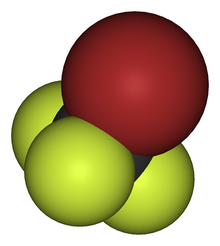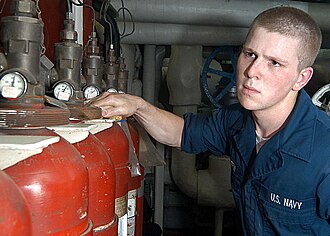 Global Information
Global InformationBromofluorocarbon information

Bromofluorocarbons (BFCs) are molecules based on carbon, bromine, and fluorine. The most common use has traditionally been in fire suppression systems.[1] The brand name "Halon" is frequently used interchangeably for BFCs. owever, not all Halons are technically BFCs (some contain chlorine also).
BFCs attack the ozone layer even more aggressively than chlorofluorocarbons (CFCs),[2] and are powerful greenhouse gases, although due to shorter atmospheric lifetimes not as powerful as equivalent perfluorocarbons or chlorofluorocarbons.[3] Nevertheless, BFCs are still used in some ships and aircraft, because replacements are not as effective. As production of BFCs was banned by the Montreal Protocol,[1] remaining use depends on old inventories and on recycling.[4]
BFCs are extremely inert. In a fire, in addition to physically excluding oxygen, the molecules liberate bromine radicals which interfere with combustion reactions. BFCs tend to have higher melting and boiling points than comparable fully fluorinated molecules.

- ^ a b Chambers, Richard D. (2004). Fluorine in Organic Chemistry. CRC Press. p. 4. ISBN 0849317908.
- ^ Misra, Kula C. (2012). "13.3.1 Depletion of stratospheric ozone – the "ozone hole"". Introduction to Geochemistry: Principles and Applications. John Wiley & Sons. ISBN 9781444347197.
- ^ See Hodnebrog, Ø., M. Etminan, J. S. Fuglestvedt, G. Marston, G. Myhre, C. J. Nielsen, K. P. Shine, and T. J. Wallington (2013), ‘Global warming potentials and radiative efficiencies of halocarbons and related compounds: A comprehensive review,’ Reviews of Geophysics, vol. 51, pp. 300-378, doi:10.1002/rog.20013.
- ^ Committee on Assessment of Fire Suppression Substitutes and Alternatives to Halon (Commission on Physical Sciences, Mathematics, and Applications, National Research Council) (1997). "Executive summary". Fire suppression substitutes and alternatives to Halon for U.S. Navy applications. National Academies Press. p. 1. ISBN 978-0-309-07492-6.